by Federico Giannini (Instagram: @federicogiannini1), published on 14/10/2015
Categories: Works and artists
- Viaggi / Disclaimer
The Malatesta Temple in Rimini reflects all the ambitions of the lord who wanted it Sigismondo Malatesta, a figure unjustly condemned by history.
It is a bit like entering a pagan temple. And in some ways even a sumptuous aristocratic residence, if you prefer. What is certain is that the sacred and the religious seem to be relegated to a marginal role: these are the feelings one gets when crossing the threshold of the Malatesta Temple, the building designed and built to celebrate the ambitions of the lord of Rimini, Sigismondo Malatesta (1417 - 1468). Or rather: more than ambitions, velleities. And the Temple’s state of unfinishedness becomes a visual synonym for that desire to make the small and marginal lordship of Rimini a strong state that could expand at the expense of its neighbors. Certainly, Sigismondo Malatesta could be blamed for his lack of loyalty to allies, his excessive bellicosity, the fact that he antagonized many of the most powerful rulers of the Renaissance, and his often instinctive actions. But he could not be blamed for not loving his city. So much so that when Pope Paul II, in 1467, asked him to consider ceding Rimini to the Church in exchange for certain benefits Sigismondo had demanded after participating in the war in Morea against the Turks, the proud Malatesta considered that he would never cede “that poor city that is left to me, where most of the bones of my antiqui are,” and that “it is better to die with honor than to receive such vilification.” And to the pope himself he said that “io aspettaria innanzi mille morti che lassarmi congiongere a tal caso e victoperio di tutti li miei passati.” Stubbornness rewarded Sigismund, who at the end of his life, poor, defeated and disappointed, still managed to retain Rimini.
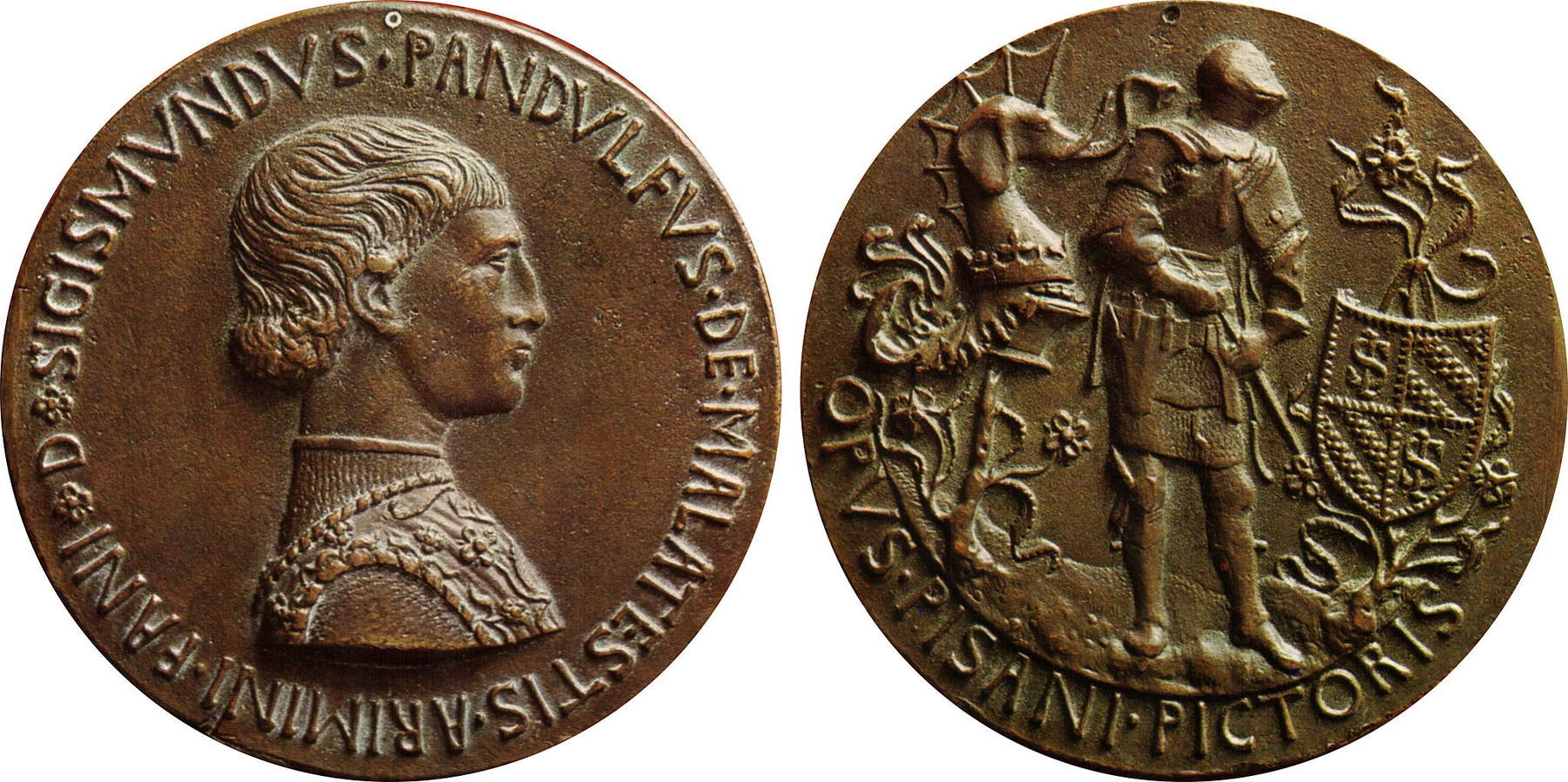 |
| Pisanello, Medal of Sigismondo Malatesta (1445) |
History, it is known, is written by the victors. And Sigismondo Malatesta’s victors spread a picture of the lord of Rimini in such gloomy hues that for centuries he was hastily and unfairly regarded as a crude and bloodthirsty tyrant. In fact, few Renaissance figures were as fascinating as that of Sigismondo Malatesta. And to get to know him more closely, one must travel to Rimini and enter the Malatesta Temple. The events that led to the rebuilding of the ancient church of San Francesco have been outlined with some precision (although it still remains impossible to establish with absolute certainty the history of the building site), and they start in the late 1540s, when Sigismondo was at the height of his glory. His successful military campaigns had in fact brought him substantial earnings, through which the lord of Rimini had been able to devote himself to his flourishing activity as a patron of the arts and culture: he thus gathered in Romagna a highly refined court of poets (and he himself was a poet), intellectuals, men of letters, and artists. Not only because Sigismondo was a great lover of art and letters, but also because through the work of his intellectuals, he intended to celebrate his family, to exalt it almost as if it were the object of a cult, the central figure of a very special religion. And, as other Renaissance lords also did, Sigismondo sought to link the history of his own family (and his own person) to a repertoire of ancient symbols, drawn from classicism. The Malatesta Temple therefore became the symbol of this cultural policy. The history of the building began in 1447, and the plans were entrusted to Leon Battista Alberti (1404 - 1472), who, beginning around 1453, was given the task of arranging the exterior, and to Matteo de’ Pasti (1412 - 1468), who was called upon instead to revise the interior.
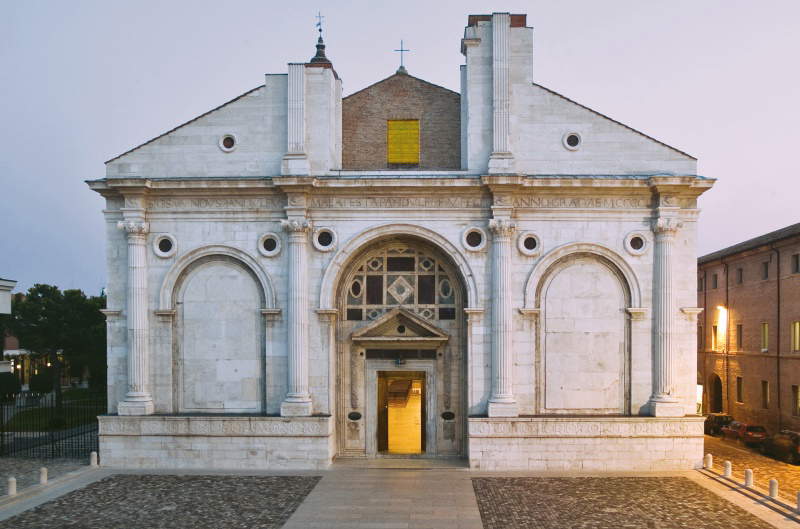 |
| The Malatesta Temple in Rimini |
Leon Battista Alberti entered the scene when the work had already begun (in fact, they started from the interior), and conceived a temple with a completely innovative conception: in fact, he adopted, for the façade, the typical structure of the Romantriumphal arch, taking broad inspiration from theArch of Augustus in Rimini, which is located just a few steps from the area on which the Temple stands. It was the first time that the model of the triumphal arch was adopted for a church: thus, the major arch frames the portal of access to the Temple, while the two side arches, according to the original plan, should have been deeper in order to accommodate the tombs of Sigismondo and his beloved, Isotta degli Atti, later placed in two chapels inside the church. And again, like the ancient temples, the Malatesta Temple rests on a high stylobate, or horizontal plane on which the columns rest. The fact that the exterior remained unfinished does not invalidate the judgment on the work, which we can consider the first practical application of Leon Battista Alberti’s theories, also expressed in his treatise De re aedificatoria, about architecture understood as harmony, rigorous simplicity, rightness of proportions, drawing inspiration directly from the ancient. And, again as in an ancient temple, here too Leon Battista Alberti inserts a frieze on which runs the inscription SIGISMUNDUS PANDULFUS MALATESTA PANDVLFI F V FECIT ANNO GRATIAE MCCCCL, or “Sigismondo Pandolfo Malatesta, son of Pandolfo, accomplished by vow in the year of grace 1450.” The celebration of the lord and the declarations of his intent begin already from this inscription, and not only because Sigismondo wanted to imprint his name on the facade so that everyone could understand to whom the Temple’s undertaking was owed. But also because the date placed in the inscription is quite significant: 1450 was a jubilee year, as well as the year in which Pope Nicholas V renewed the apostolic vicariate (a sort of official legitimization, by the Church, of a lord’s power) to both Sigismondo and his brother Domenico, known as Malatesta Novello, lord of Cesena. But not only that: on the same occasion, the pope also legitimized Sigismondo’s two male sons and guaranteed the vicariate to the Malatesta family for three generations. Sigismondo saw all this as the legitimization of a strong dynasty destined to last: the Temple was thus configured as a kind of mausoleum for the family, whose patronymic Sigismondo was, moreover, a continuator, since the inscription also highlights the patronymic.
 |
| Part of the inscription on the facade of the Temple |
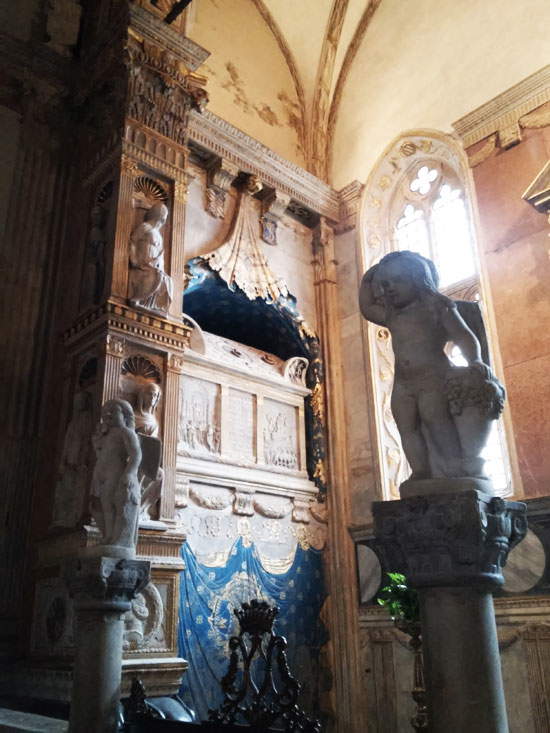 |
| The Chapel of the Sibyls and Prophets with, on the left, the ark of Sigismund’s ancestors and descendants. At the base of the pillar in the foreground can be seen the effigy of Sigismondo Malatesta. |
However, if the vicariate apostolic office conferred prestige on the dynasty, it is also true that the ambitious Sigismondo aspired to higher titles, which, however, he never obtained, and these frustrated ambitions of his were one of the reasons for his numerous frictions with the papacy, which later resulted in very serious disagreements. And this is whypapal authority, within the Malatesta Temple, was challenged on several occasions. Beginning with the celebrated fresco by the great Piero della Francesca (1412 - 1492), who also gravitated around Sigismondo’s court, which depicts the lord of Rimini praying before St. Sigismund. The saint, a historically existent personage (he was king of the Burgundians between 516 and 523) is not depicted, as per typical iconography, with youthful features, but rather as an old man, holding a scepter with one hand and a globe with the other: Saint Sigismund was in fact depicted with the typical symbols of imperial power and with the features of Emperor Sigismund of Luxembourg, who in 1433 had granted the title of knight to a barely 16-year-old Sigismondo Malatesta, thus conferring imperial legitimacy on his power and his family. The message is clear: Sigismondo Malatesta openly declares his loyalty to imperial power, especially since two dogs also appear, symbols, precisely, of loyalty and vigilance. And this message, included in a fresco inside the city’s main church, constituted a kind of challenge to the papacy. And again: the first chapel on the right, the Chapel of St. Sigismund, conceived as Sigismund’s funeral chapel after they opted to house the tomb inside the Temple, is adorned with figures of the Virtues, usually reserved, in similar chapels, for the burials of kings and princes or at any rate of sovereigns eager to recall with allegories what good had been done during their rule. Here, too, then, the idea is to present himself to the world as a powerful ruler.
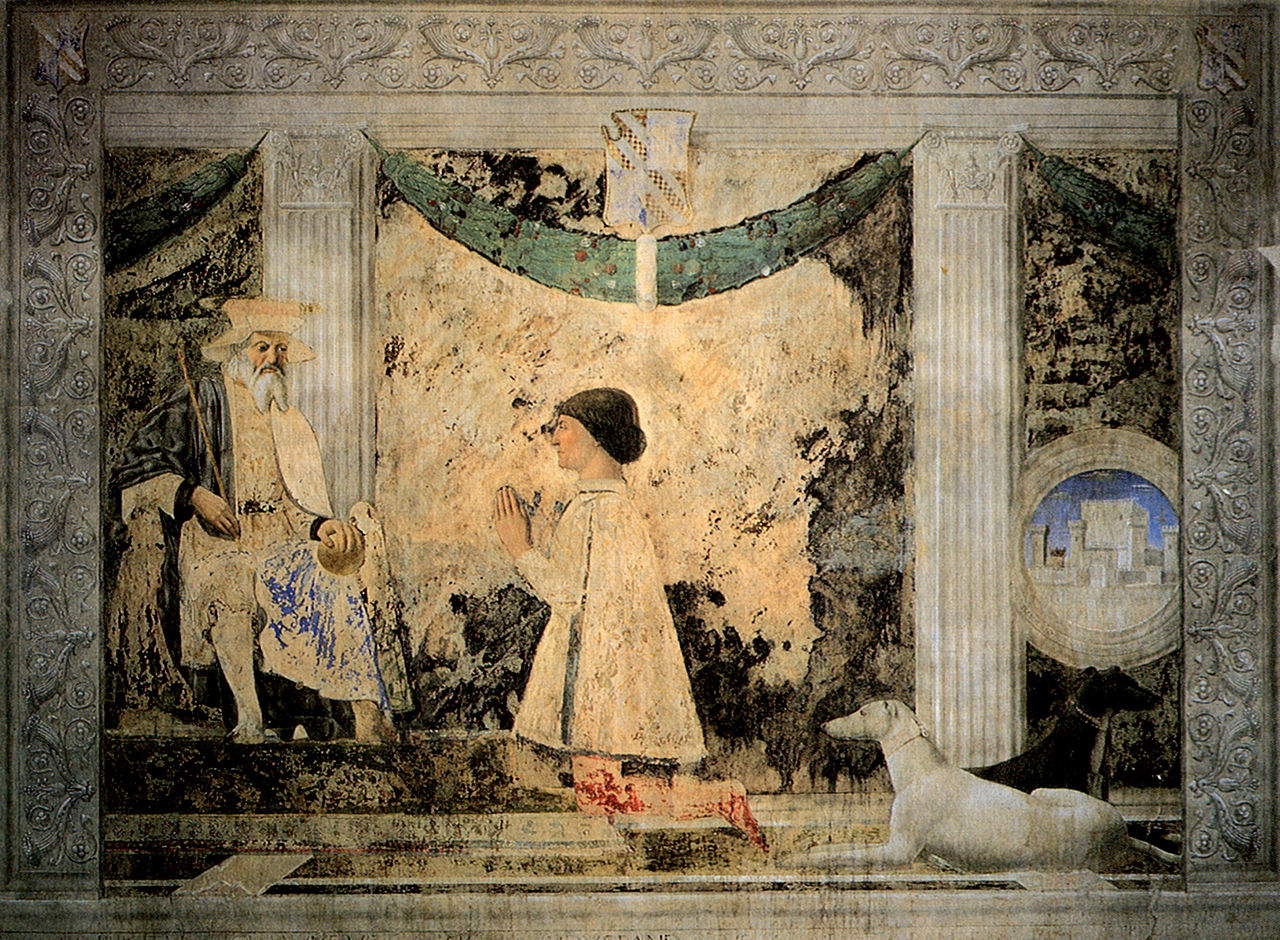 |
| Piero della Francesca, Sigismondo Malatesta at Prayer before Saint Sigismund (1451; Rimini, Malatesta Temple) |
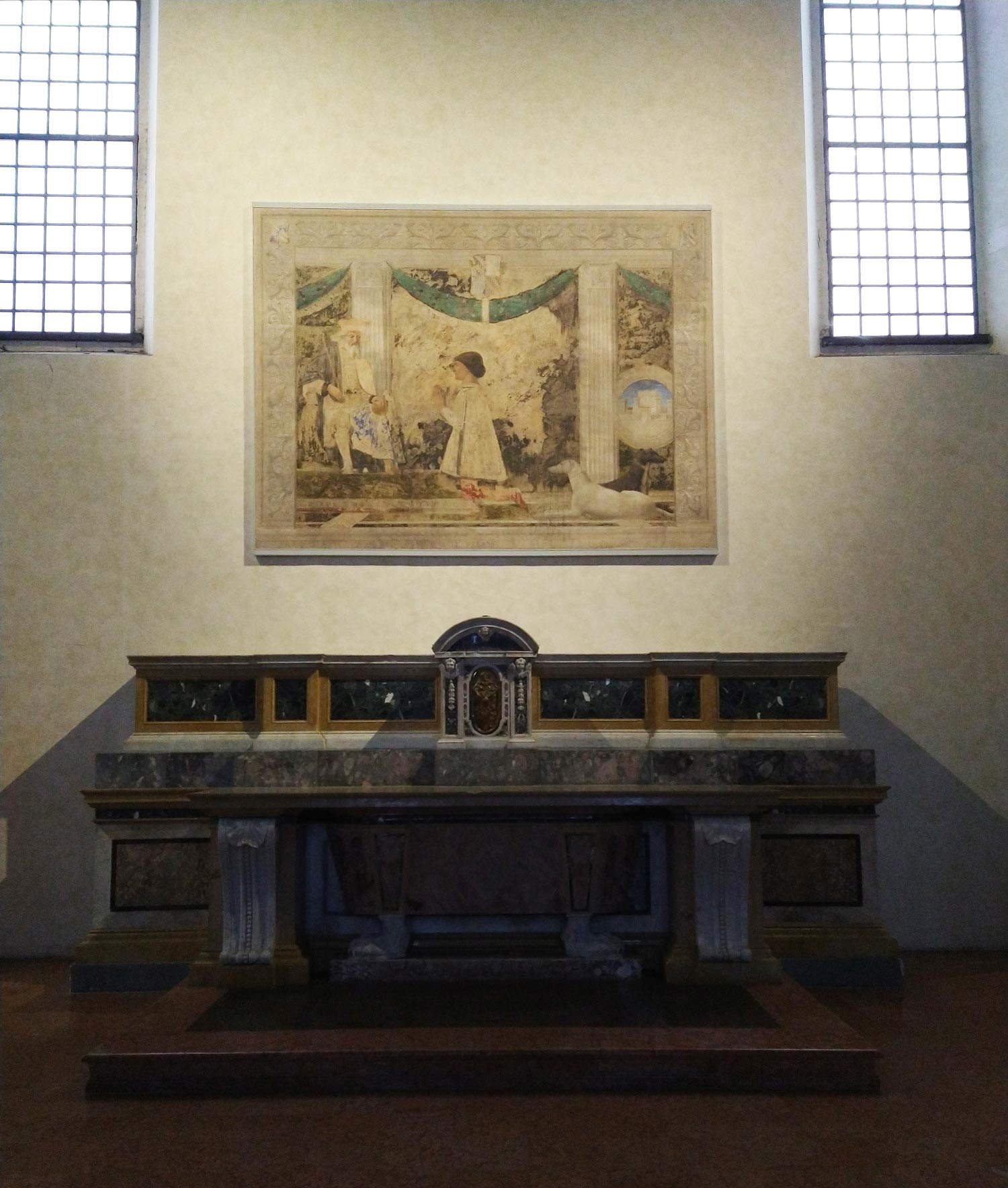 |
| Piero della Francesca’s fresco inside the Temple |
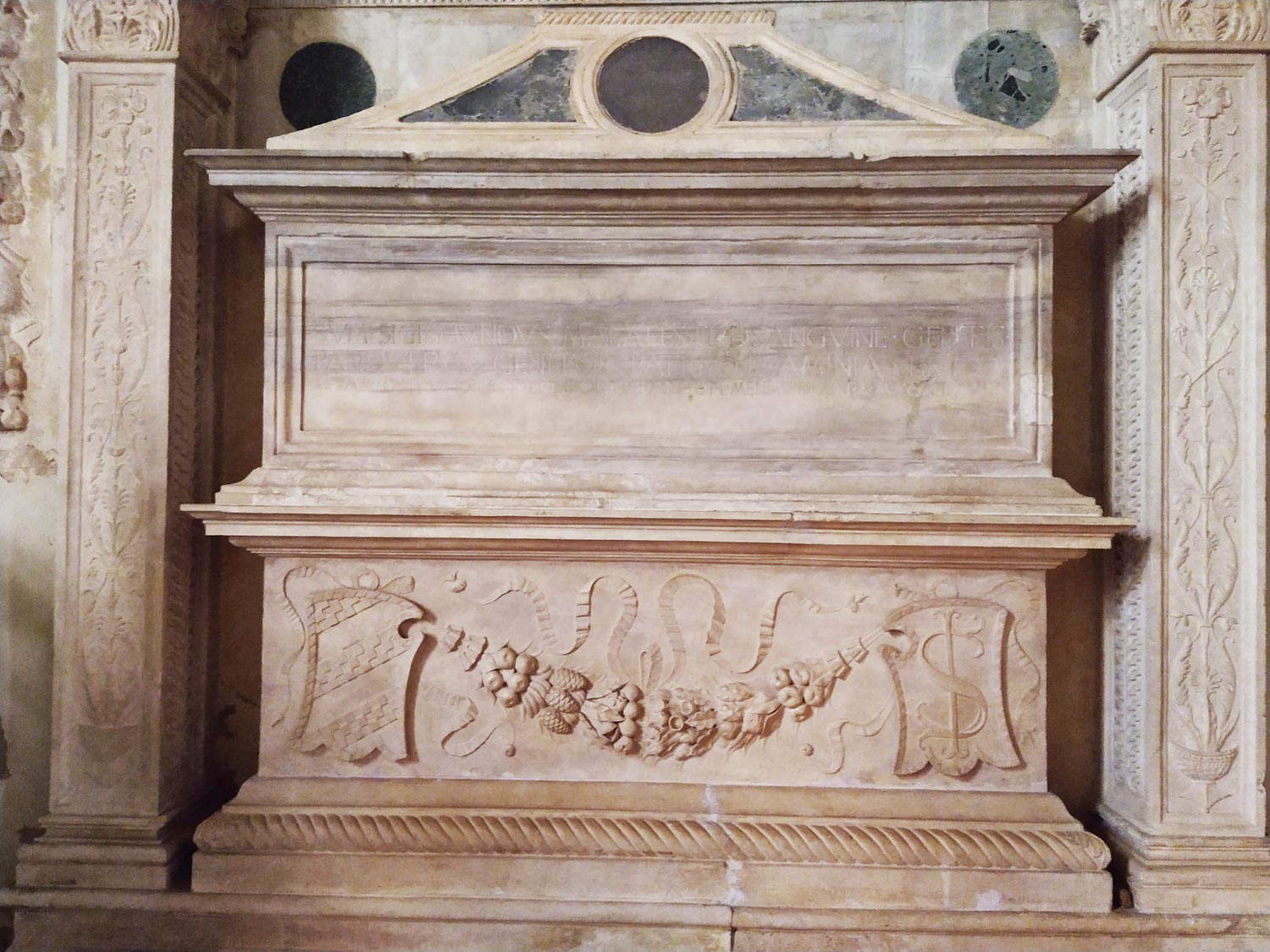 |
| The Tomb of Sigismondo Malatesta |
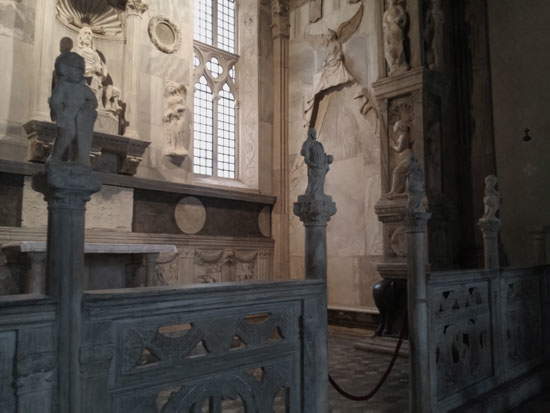 |
| The Chapel of San Sigismondo |
Indeed, inside the Malatesta Temple, every bit of decoration is thought out and designed to glorify Sigismondo and his family. Typical Malatesta symbols recur everywhere, beginning with theelephant: we find it as a helmet crest, at the base of pillars and columns, within decorative elements, and even holding the tomb of Isotta degli Atti. It is a symbol of strength, power, and imperturbability because, as Malatesta Novello’s motto goes, elephas indus culices non timet, “the Indian elephant does not fear mosquitoes,” signifying that large people do not care for the annoyances brought by small ones, and the elephant thus became one of the Malatesta symbols par excellence. And again we find the feat of the three heads, which visually recalls the name of the Malatesta family because it depicts three heads of as many Moors (i.e., of infidels, bad heads, hence “evil heads”) who were allegedly killed by the legendary progenitor of the lineage, the mythical Trojan hero Tarcone, son of the Trojan king Laomedon. Appearing very often is the depiction of the dog rose (we also find it in the coffers that adorn the arch that houses Sigismondo’s tomb), through which the Malatesta wanted to attribute to themselves descent from the Roman family of the Scipios whose symbol was, precisely, the four-petaled rose. Finally, everywhere we see repeated everywhere the symbol of the intertwined S and I: it is the first syllable of the name Sigismondo, but for a long time there were those who believed (and perhaps still do) that it was actually the initials of the names of Sigismondo and Isotta, who in this way wished to seal their love inside the temple.
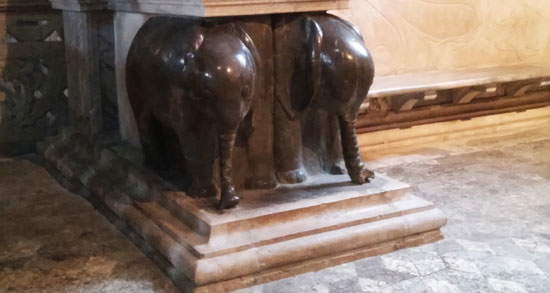 |
| Malatesta elephants |
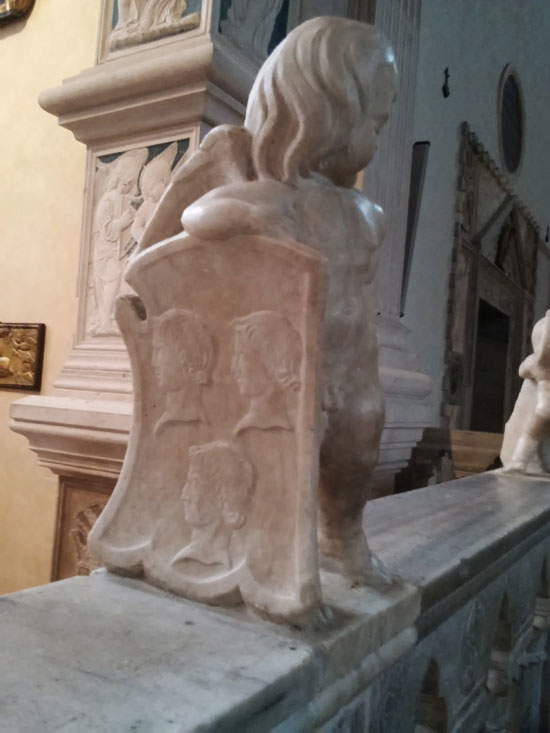 |
| The three-headed emblem held up by a putto |
 |
| The intertwined S and I |
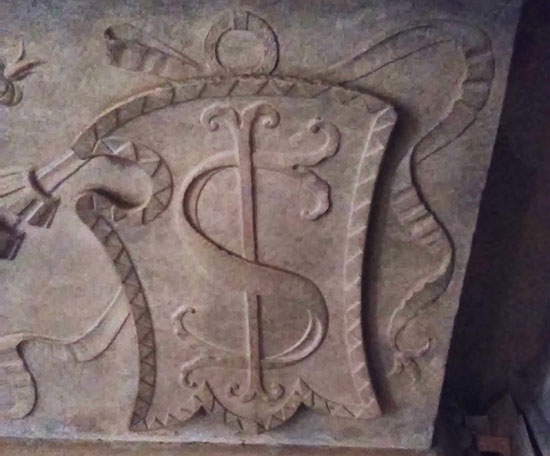 |
| Another depiction of the S and I |
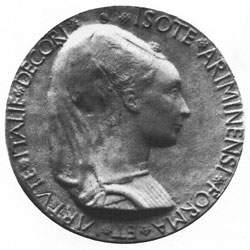 |
| Matteo de’ Pasti, Medal of Isotta degli Atti (1446) |
Indeed, it is necessary to highlight the importance of the role of Isotta degli Atti (c. 1432 - 1474) within the Temple. The gentlewoman, of non-noble origins, was first Sigismondo’s mistress, when the lord of Rimini was married to Polissena Sforza, and later, in 1456, she became his wife: it was one of the rare disinterested marriages of the Renaissance, because by marrying the young woman, Sigismondo would not gain any political advantage (except for the legitimation of the children she had outside of marriage), however, he would crown the dream of love that he was pursuing but that the reason of state had not yet allowed him to achieve. The love between the two was so passionate that poets at the court of Rimini sang it over and over again, giving rise to the strand of so-called Isottean poetry. And it was so passionate that, as mentioned, inside the Malatesta Temple Sigismondo’s wife plays a leading role. Sigismondo had thought of celebrating Isotta from the earliest plans for the Temple, in 1447, when they were not yet married: after all, it was by no means a mystery that the lord of Rimini cultivated such a relationship outside the bonds of marriage. Isotta’s tomb thus occupies a prominent position within the Temple: it is placed in the chapel of San Michele, where it occupies an entire wall adorned with a marked decorativism of late Gothic matrix (one of the peculiar characteristics of the Malatesta Temple is, precisely, the contrast between the accomplishedly Renaissance exterior, and the interior still linked to courtly Gothic). And, at the time when the tomb was made, it aroused enormous scandal. It is in fact accompanied by an epigraph that reads, “D. ISOTTAE ARIMINENSI B.M. / SACRUM MCCCL.” The dotted D, at the time, was read as an abbreviation of Divae, “Divine,” an appellation reserved for saints, while the B was interpreted as an abbreviation of Beatae, another adjective indicating a condition peculiar to personages belonging to the sphere of the sacred, bliss. Translated, the epigraph could therefore sound like this: “Consecrated in 1450 to the blessed memory of the divine Isotta of Rimini.” Interpreted in this way, the phrase had the flavor of blasphemy, because Sigismondo allowed himself, without being vested with any authority by the Church, to elevate his wife to the rank of saints and blessed (it was as if on the tomb was written “to Saint Isotta”). More likely, the “D” stands for “Dominae” and the “B” stands for “bonae,” and the phrase would therefore be read, innocuously, as “Consecrated in 1450 to the good memory of Mrs. Isotta of Rimini”: but at the time of Pope Pius II, who was probably Sigismondo Malatesta’s fiercest enemy, the two letters were enough to make people cry out in scandal.
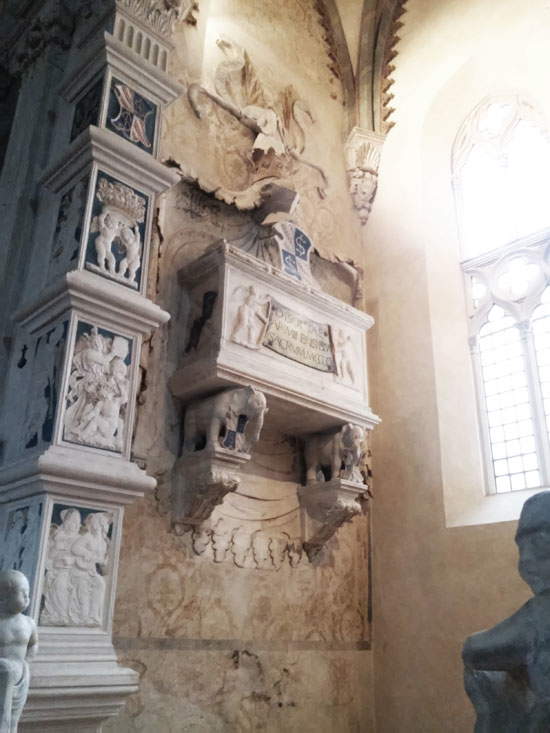 |
| The tomb of Isotta degli Atti |
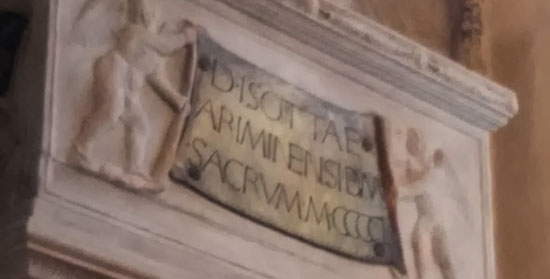 |
| The epigraph on Isolde’s tomb. |
The Temple therefore was seen as one of many disrespectful manifestations towards religion by Sigismondo, against whom the pope launched a very violent indictment in 1461. Pius II was an ally of Ferdinand I of Aragon, who claimed conspicuous credit from Sigismondo, which the lord of Rimini already owed to his late father, but which he was struggling to honor. The pope repeatedly called Sigismondo Malatesta back to his duties, but on Christmas Day 1460, given his continued disobedience (and given above all his desire to dispose of a valiant leader who had always given the Church trouble), he launched an excommunication against him and his brother Dominic and, in a consistory convened on January 16, 1461, held a kind of trial in absentia during which terrible accusations were hurled against Sigismondo. The lord of Rimini was accused of being a heretic, a blasphemer, a murderer, and a uxoricide (in fact, the pope accused him of having killed his first two wives in order to be able to dissolve his marriage bonds), and of regularly committing thefts, incest, rape, and violence even against children. And a personality in the pontiff’s view so deviant, he could only have a temple built in his own image. In 1462 Pius II, in the Commentarii, his work of historical memoirs of those times, painted the Malatesta Temple in these terms: Aedificavit tamen nobile templum Arimini in honorem divi Francisci, verum ita gentilibus operibus implevit, ut non tam Christianorum quam infidelium daemones adorantium templum esse videatur, “He had a noble temple built in Rimini dedicated to St. Francis, yet he filled it with pagan works, so that it looked like a temple not of Christians, but of infidels worshippers of demons.”
It may be that, when entering the Malatesta Temple, the feeling, as mentioned in the opening, is that of entering a pagan temple. In reality, the iconographic program of the building is nothing more than the visual manifestation of the intellectual and philosophical sophistication of the milieu of mid-fifteenth-century Rimini, so classical and neo-Platonic elements, with an abundance of literary and philosophical quotations, are interwoven with the themes of religion, for a very complex reading, which perhaps we will discuss on another occasion. What is certain is that the accusation that Sigismondo Malatesta disrespected the Christian religion turns out to be unfounded: not least because, if that had been the case, the Franciscan friars who administered worship inside the church would have been the first to rebuke the lord. But Pius II’s contempt for Sigismondo was enough to justify extravagant interpretations of the church’s decorative apparatus.
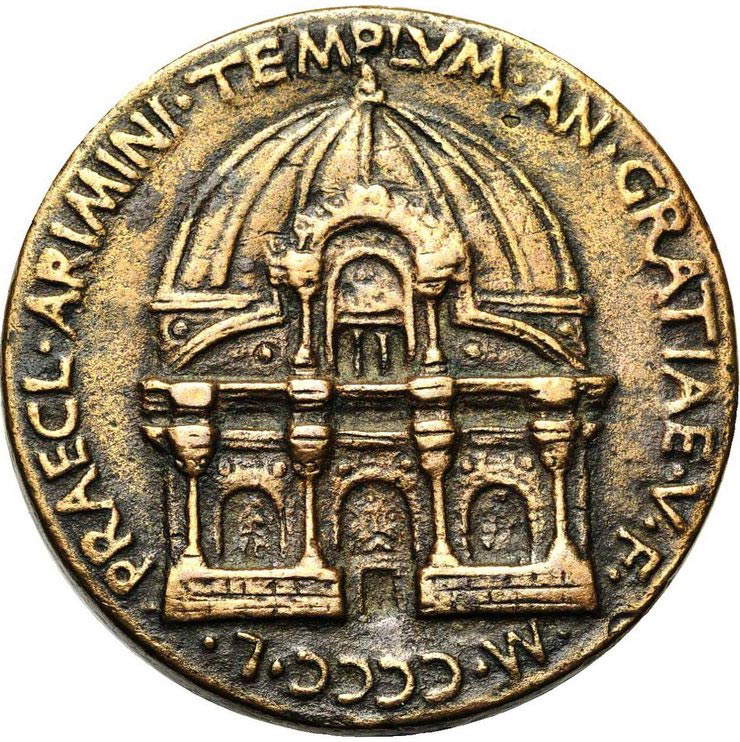 |
| Matteo de’ Pasti, recto of the commemorative medal of Sigismondo Malatesta, showing the design of the Malatesta Temple (1450) |
As a result of the indictment, the pope cursed Sigismondo, condemned him to the fires of hell, dissolved the subjects of Rimini from the bond of loyalty to the lord, and finally, in April 1462, revoked every honor given by the Church to Sigismondo, his relatives and his descendants up to the fourth generation, and organized a sort of “mock execution” in several squares of Rome, during which effigies of Sigismondo Malatesta, portrayed life-size, were burned at the stake. Not satisfied with this, the pope, who fervently desired Sigismondo’s downfall, also promoted a war effort against the lord of Rimini, who certainly did not stand idly by: however, after some initial successes, he was finally defeated by his lifelong rival, Federico da Montefeltro, an ally of the pope. After his defeat in the war, the Venetian Republic, which was on good terms with the Malatesta, asked the pope not to rage against Sigismondo and Rimini, and the lord, in order to avoid a bad end for both him and the city, asked for and obtained a papal pardon. He remained isolated, however, and to rehabilitate his image he participated in the expedition to Morea. Of what followed, we spoke at the beginning of the article: Sigismondo tried to obtain benefits from the new pope, who was more benevolent than Pius II toward him, but in the end he succeeded only in retaining lordship over Rimini. Sigismondo Malatesta died during the following year, 1468: that year also saw the end of the story of the Malatesta Temple, work on which had already stopped at the time of the clashes with Pius II. No drawings or models remain of what it should have looked like when finished. But the grandeur it was supposed to emanate is evoked by the famous medal by Matteo de’ Pasti, who, moreover, was the only one of Sigismondo’s artists to remain with him until the end. It is the only work we know of in which we can see the Temple as it should have been when finished. The upper register of the facade should have ended with a large round arch, connected to the lower register by two volutes that would have decorated the two triangular elevations. And at the bottom should have been a majestic rotunda crowned with a dome, similar to that of the Pantheon in Rome. Work that never saw the light of day: the Temple remained permanently unfinished, like the dreams of the lord who had strongly desired it. A lord condemned by history, on unfounded and specious grounds: his rehabilitation is a recent fact. But whose intelligence and glory are eternalized in a Temple that bears the name of his family: and in this we can say that Sigismondo Malatesta achieved his goal, for there is no fame more lasting and more glorious than that which art can guarantee.
Warning: the translation into English of the original Italian article was created using automatic tools.
We undertake to review all articles, but we do not guarantee the total absence of inaccuracies in the translation due to the program. You can
find the original by clicking on the ITA button. If you find any mistake,please contact us.













































